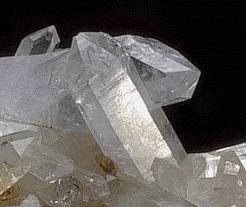
|
 |

Mineral Identification
MINERALS
A mineral is any naturally-occurring, homogeneous solid that has a definite chemical composition and a distinctive internal crystal structure. Minerals are usually formed by inorganic processes. Synthetic equivalents of some minerals, such as emeralds and diamonds, are often produced in the laboratory for experimental or commercial purposes.
Although most minerals are chemical compounds, a small number (e.g., sulfur, copper, gold) are elements. The composition of a mineral can be defined by its chemical formula. The identity of its anionic group determines the group into which the mineral is classified. For example, the mineral halite (NaCl) is composed of two elements, sodium (Na) and chlorine (Cl), in a 1:1 ratio; its anionic group is chloride (Cl-)--a halide--so halite is classified as a halide. Minerals can thus be classified into the following major groups: native elements, sulfides, sulfosalts, oxides and hydroxides, halides, carbonates, nitrates, borates, sulfates, phosphates, and silicates. Silicates are the most commonly occurring minerals because silica is the most abundant constituent of the Earth's crust (about 59 percent).
A mineral crystallizes in an orderly, three-dimensional geometric form, so that it is considered to be a crystalline material. Along with its chemical composition, the crystalline structure of a mineral helps determine such physical properties as hardness, color, and cleavage.
Minerals combine with each other to form rocks. For example, granite consists of the minerals feldspar, quartz, mica, and amphibole in varying ratios. Rocks are thus distinguished from minerals by their heterogeneous composition. A mere 100 of the several thousand known types of minerals constitute the main components of rocks.
PHYSICAL PROPERTIES
Approximately 3,000 minerals exist in nature. How do we identify them? Remember minerals differ from one another because each has a specific chemical composition and a unique three-dimensional arrangement of atoms within its structure. These differences result in a variety of physical properties, including the minerals' appearance, how they break, how well they resist being scratched, even how they smell, taste, and feel. Not all of these properties are equally useful. What if you were going to an airport to pick up someone you had never met, armed with a description provided by someone who had last seen your arriving passenger 25 years ago? Which features in the description would be most helpful? Height? Weight? Hair color? Some aspects of human features change markedly with time, while others, like eye color or shape of head, do not.
The problem is the same with minerals. Some properties never change. These are the most useful for identifying a mineral and are called diagnostic properties. Others, like a person's weight, may vary widely (not with time, but from specimen to specimen of the same mineral). You should be able to decide which of the following properties are truly diagnostic properties, and which are less useful. Click on each of the physical properties below to learn what they are and how to use them to identify minerals.
Now you are ready to enter the world of minerals. Let's try to identify some
common minerals. 
|

